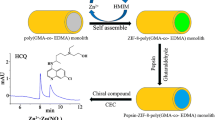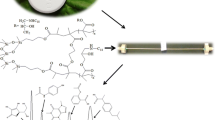Abstract
Cationic vinylpyridine based molecularly imprinted polymer monoliths were, for the first time, applied to enantiomer separation using capillary electrochromatography. In order to map the synthesis conditions under which superporous monoliths are obtained, capillary columns were prepared by an in situ polymerization technique using varying monomer and porogen compositions. Both electrolyte pH and percentage of the organic modifier acetonitrile were found to affect the electrochromatographic behaviour on such columns. An interesting observation is that the electroosmotic flow changed direction from cathodic at high pH to anodic at low pH of the electrolyte, opening up the opportunity to manipulate the flow. This is attributed to the vinylpyridine based MIP becomes protonated and positively charged at low pH, whereas it is uncharged at high pH where instead negatively charged silanol groups drive the electroosmotic flow. Improved enantiomer resolution, as well as increased retention, was observed when the concentration of acetonitrile in the electrolyte decreased, indicating a significant element of hydrophobic effects in the molecular recognition of the imprinted enantiomer. Enantiomer separation of the non-steroidal anti-inflammatory drug ibuprofen was studied and efficiencies as high as 30,000 plates per meter with an asymmetry factor below 4 were obtained for the last eluting imprinted enantiomer. These values are better than that obtained generally using MIP based chromatography.







Similar content being viewed by others
References
Sellergren B (eds) (2001) Molecularly imprinted polymers: man-made mimics of antibodies and their applications in analytical chemistry, Elsevier, New York
Mosbach K (1994) Trends Biochem Sci 19:9–14. doi:10.1016/0968-0004(94)90166-X
Alexander C, Andersson HS, Andersson LI, Ansell RJ, Kirsch N, Nicholls IA et al (2006) J Mol Recognit 19:106–180. doi:10.1002/jmr.760
Sellergren B (2001) J Chromatogr A 906:227–252. doi:10.1016/S0021-9673(00)00929-8
Kim H, Kaczmarski K, Guiochon G (2006) Chem Eng Sci 61:5249–5267. doi:10.1016/j.ces.2006.03.043
Tóth B, Pap T, Horvath V, Horvai G (2006) J Chromatogr A 1119:29–33. doi:10.1016/j.chroma.2005.10.048
Umpleby RJII, Baxter SC, Rampey AM, Rushton GT, Chen Y, Shimizu KD (2004) J Chromatogr B Analyt Technol Biomed Life Sci 804:141–149. doi:10.1016/j.jchromb.2004.01.064
Jorgenson JW, Lukacs KD (1981) J Chromatogr A 218:209–216. doi:10.1016/S0021-9673(00)82057-9
Cikalo MG, Bartle KD, Robson MM, Myers P, Eubery MR (1998) Analyst (Lond) 123:87R–102R. doi:10.1039/a801148f
Lin JM, Nakagama T, Uchiyama K, Hobo T (1996) Chromatographia 43:585–591. doi:10.1007/BF02292972
Chirica G, Remcho VT (1999) Electrophoresis 20:50–56. doi:10.1002/(SICI)1522-2683(19990101)20:1<50::AID-ELPS50>3.0.CO;2-O
Quaglia M, De Lorenzi E, Sulitzky C, Caccialanza G, Sellergren B (2003) Electrophoresis 24:952–957. doi:10.1002/elps.200390138
Quaglia M, De Lorenzi E, Sulitzky C, Massolini G, Sellergren B (2001) Analyst (Lond) 126:1495–1498. doi:10.1039/b105401p
Schweitz L, Andersson LI, Nilsson S (1997) Anal Chem 69:1179–1183. doi:10.1021/ac9607929
Tan JZ, Remcho VT (1998) Electrophoresis 19:2055–2060. doi:10.1002/elps.1150191203
Schweitz L (2002) Anal Chem 74:1192–1196. doi:10.1021/ac0156520
Amini A, Paulsen-Sorman U, Westerlund D (1999) Chromatographia 50:497–506. doi:10.1007/BF02490748
Spégel P, Schweitz L, Nilsson S (2003) Anal Chem 75:6608–6613. doi:10.1021/ac034732w
Spégel P, Schweitz L, Nilsson S (2001) Electrophoresis 22:3833–3841. doi:10.1002/1522-2683(200109)22:17<3833::AID-ELPS3833>3.0.CO;2-9
Schweitz L, Spégel P, Nilsson S (2000) Analyst Lond 125:1899–1901. doi:10.1039/b007221o
de Boer T, Mol R, de Zeeuw RA, de Jong GJ, Sherrington DC, Cormack PAG et al (2002) Electrophoresis 23:1296–1300. doi:10.1002/1522-2683(200205)23:9<1296::AID-ELPS1296>3.0.CO;2-2
Haginaka J (2002) Bioseparations 10:337–351. doi:10.1023/A:1021550005389
Sellergren B, Lepistö M, Mosbach K (1988) J Am Chem Soc 110:5853–5860. doi:10.1021/ja00225a041
Andersson LI, Mosbach K (1990) J Chromatogr A 516:313–322. doi:10.1016/S0021-9673(01)89273-6
Ramström O, Andersson LI, Mosbach K (1993) J Org Chem 58:7562–7564. doi:10.1021/jo00078a041
Kempe M, Fischer L, Mosbach K (1993) J Mol Recognit 6:25–29. doi:10.1002/jmr.300060103
Kempe M, Mosbach K (1994) J Chromatogr A 664:276–279. doi:10.1016/0021-9673(94)87016-0
Haginaka J, Sanbe H (2001) J Chromatogr A 913:141–146. doi:10.1016/S0021-9673(01)00555-6
Ye L, Ramström O, Mosbach K (1998) Anal Chem 70:2789–2795. doi:10.1021/ac980069d
Lin JM, Nakagama T, Uchiyama K, Hobo T (1997) J Pharm Biomed Anal 15:1351–1358. doi:10.1016/S0731-7085(96)02013-4
Schweitz L, Andersson LI, Nilsson S (1997) J Chromatogr A 792:401–409. doi:10.1016/S0021-9673(97)00895-9
Nilsson J, Spégel P, Nilsson S (2004) J Chromatogr B Analyt Technol Biomed Life Sci 804:3–12. doi:10.1016/j.jchromb.2003.12.036
Lin JM, Nakagama T, Uchiyama K, Hobo T (1997) J Liquid Chromatogr Relat Technol 20:1489–1506. doi:10.1080/10826079708010989
Haginaka J, Sanbe H, Takehira H (1999) J Chromatogr A 857:117–125. doi:10.1016/S0021-9673(99)00764-5
Haginaka J, Takehira H, Hosoya K, Tanaka N (1999) J Chromatogr A 849:331–339. doi:10.1016/S0021-9673(99)00570-1
Natansohn A, Maxim S, Feldman D (1979) Polymer (Guildf) 20:629–635. doi:10.1016/0032-3861(79)90179-4
Schweitz L, Andersson LI, Nilsson S (2002) Analyst (Lond) 127:22–28. doi:10.1039/b105104k
Schweitz L, Andersson LI, Nilsson S (2001) Anal Chim Acta 435:43–47. doi:10.1016/S0003-2670(00)01210-1
Byrne CD, Smith NW, Dearie HS, Moffatt F, Wren SAC, Evans KP (2001) J Chromatogr A 927:169–177. doi:10.1016/S0021-9673(01)01061-5
Schwer C, Kenndler E (1991) Anal Chem 63:1801–1807. doi:10.1021/ac00017a026
Karlsson JG, Andersson LI, Nicholls IA (2001) Anal Chim Acta 435:57–64. doi:10.1016/S0003-2670(00)01182-X
Acknowledgments
We gratefully acknowledge the financial support from the Carl Trygger foundation, The Swedish Fund for Research without Animal Experiments, Kungliga Fysiografiska Sällskapet i Lund, the Swedish research Council (VR) (Grant No 40455901 to SN), the Crafoord Foundation and AstraZeneca.
Author information
Authors and Affiliations
Corresponding author
Rights and permissions
About this article
Cite this article
Spégel, P., Schweitz, L., Andersson, L.I. et al. Novel Vinylpyridine Based Cationic MIP Monoliths for Enantiomer Separation in CEC. Chroma 69, 277–285 (2009). https://doi.org/10.1365/s10337-008-0911-0
Received:
Revised:
Accepted:
Published:
Issue Date:
DOI: https://doi.org/10.1365/s10337-008-0911-0




